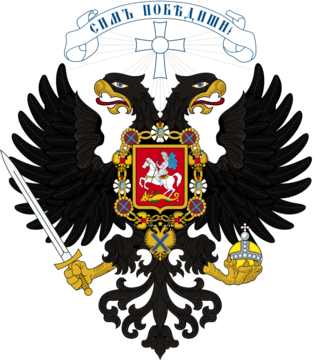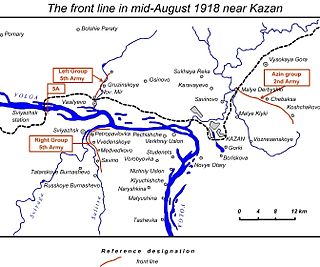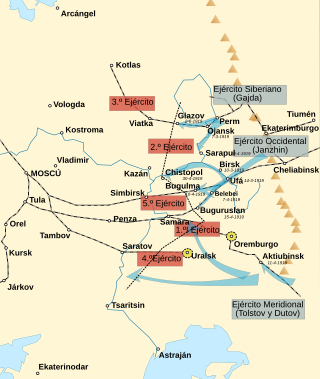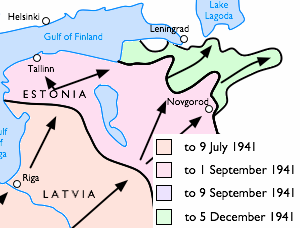The battle
At first Red's advancing was slow. Volsk Division captured Khvalynsk in September, 16, but lost the town after the White's counterattack. Simbirsk Division had to defend Simbirsk against White's counterattack, therefore 1st Army could use two divisions only in its advance to Syzran.
At September, 21, the commander of Eastern Front ordered the 4th Army to assist the 1st Army in capturing Syzran, and then to attack Samara. The advance progressed, at September, 26, Volsk Division captured Khvalynsk again, Penza Division moved close to Syzran.
The next day, Simbirsk Division took part in advancing after the victory near Simbirsk, and 1st Army became to advance to Syzran by two groups - Northern and Southern. Samara Division of 4th Army advanced to Syzran, other troops of 4th Army advanced to Samara.
On October, 1, troops of Samara Division closed from the south to the Syzran-Samara railway and cut it. Simbirsk Division made a forced march and came close to Syzran. Ar October, 1, Syzran was captured by Reds, Whites retreated to Samara.
Volsk Division was removed to the 4th Army, and 4th Army began its advancing to Samara. On October, 7, 4th Army together with rebellion workers inside the city captured Samara.

Case Blue was the Wehrmacht's plan for the 1942 strategic summer offensive in southern Russia between 28 June and 24 November 1942, during World War II. The objective was to capture the oil fields of Baku, Grozny and Maikop for two purposes: to enable the Germans to re-supply their low fuel stock and also to deny their use to the Soviet Union, thereby bringing about the complete collapse of the Soviet war effort.

The Battle of Rostov (1941) was a battle of the Eastern Front of World War II, fought around Rostov-on-Don between the Army Group South of Nazi Germany and the Southern Front of the Soviet Union.

The White Army or White Guard, also referred to as the Whites or White Guardsmen, was a common collective name for the armed formations of the White movement and anti-Bolshevik governments during the Russian Civil War. They fought against the Red Army of Soviet Russia.

The Battle of the Sea of Azov, also known as the Chernigovka pocket was an Axis military campaign fought between 26 September 1941 and 11 October 1941 on the northern shores of the Sea of Azov on the Eastern Front of World War II during Operation Barbarossa. It resulted in a complete Axis victory over the Red Army.

The People's Army of Komuch was an anti-Bolshevik army during the Russian Civil War that fought in the Volga Region from June to September in 1918. It was established by the Socialist Revolutionary Party and led by Vladimir Kappel.

The city of Kazan was captured by the White Army in August 1918 during the Russian Civil War.
The Simbirsk Operation was the Bolshevik Red Army's offensive against Vladimir Kappel's anti-Bolshevik People's Army of Komuch and Czechoslovak Legion. The attack came at Simbirsk, on the Eastern Front of the Russian Civil War, in September 1918. The Bolsheviks re-took the city, forcing Kappel's retreat to Ufa, where his force was absorbed by the Siberian Army.

The Orel–Kursk operation was an offensive conducted by the Southern Front of the Russian Soviet Federative Socialist Republic's Red Army against the White Armed Forces of South Russia's Volunteer Army in Orel, Kursk and Tula Governorates of the Russian Soviet Federative Socialist Republic between 11 October and 18 November 1919. It took place on the Southern Front of the Russian Civil War and was part of the wider October counteroffensive of the Southern Front, a Red Army operation that aimed to stop Armed Forces of South Russia commander Anton Denikin's Moscow offensive.

The Spring Offensive of the Russian Army was an offensive of the White Army of the White movement led by Alexander Kolchak on the Eastern Front of the Russian Civil War, between March and April 1919.
The 43rd Army was a Red Army field army of World War II that served on the Eastern Front. Formed in late July 1941, the army fought in the Battle of Smolensk (1941). It was forced to retreat after German troops broke through in October 1941 and subsequently fought in the Battle of Moscow. The army then fought in the Rzhev-Vyazma Offensive. After the end of the offensive, the army held its positions and transferred to the Demidov area in late 1942. It fought in the Battle of Smolensk (1943). During the summer of 1944, the army fought in Operation Bagration. In the fall the army advanced into the Baltic region and fought in the Riga Offensive (1944) and the Battle of Memel. In 1945 the army fought in the East Prussian Offensive before being placed in reserve near the end of April. The 43rd Army was disbanded postwar in July 1946.

Leningrad strategic defensive operation is the term in Soviet historiography for the defensive operations in the area south of Leningrad by the Red Army and the Soviet Navy during World War II from 10 July to 30 September 1941. The following operations are considered as part of the strategic operation:
The 138th Rifle Division was twice formed as an infantry division of the Red Army, first as part of the buildup of forces immediately after the start of World War II in Europe. The first formation was based on the shtat of September 13, 1939 and under this organization it took part in the Winter War against Finland, arriving at the front north of Leningrad in December and performing so capably in the battles in early 1940 that it was awarded the Order of the Red Banner. Following this it was converted to serve for two years as a mountain rifle division in the Caucasus region. Following Operation Barbarossa and the German invasion of the Crimea elements of the division were committed to amphibious landings behind enemy lines in early 1942 but these proved abortive. Soon after the 138th was converted back to a standard rifle division. Arriving on the southern approaches to Stalingrad in late July the division fought on the approaches to the city through August and into September before it was assigned to 62nd Army and shipped into the factory district in mid-October. Well into November it played a leading role in defending the Barricades (Barrikady) ordnance factory, eventually becoming isolated in a thin strip of land between the factory and the Volga which became known as "Lyudnikov's Island" after its commanding officer. Following the Soviet counteroffensive that encircled the German 6th Army and other Axis forces in and near Stalingrad the division restored contact with the rest of its Army and then helped eliminate its trapped foes, for which it was raised to Guards status as the 70th Guards Rifle Division.
The 34th Rifle Division was an infantry division of the Red Army during and before World War II. The division was formed in 1923. It fought in the Soviet invasion of Manchuria in August 1945. Postwar, it became the 11th Machine Gun Artillery Division.
Viktor Grigoryevich Zholudev was a Red Army major general and posthumous Hero of the Soviet Union. Zholudev fought in the 1929 Sino-Soviet conflict, the Battle of Lake Khasan in 1938 and the 1939 Battles of Khalkhin Gol, as well as World War II. Zholudev commanded the 37th Guards Rifle Division during its defense of the Stalingrad tractor factory during the Battle of Stalingrad.
The 81st Cavalry Division was a mounted division of the Red Army that served in the first years of the Great Patriotic War. It was formed in the autumn of 1941 and served in the region south of Stalingrad while the German Army besieged that city in the autumn of 1942. During the first stages of the Soviet counteroffensive, Operation Uranus, the 81st was given a prominent role in the exploitation to the southwest, but became overextended and vulnerable to the mobile German reinforcements arriving to attempt a breakthrough to their 6th Army. The division was badly mauled in the opening stages of Operation Winter Storm, but continued to serve in Southern Front's advance on Rostov and on into the Donbass. It was finally disbanded in May, 1943.

The Southern Front was a front of the Red Army during the Russian Civil War, formed twice.

The Voronezh-Kastornoye operation was an offensive operation by the Red Army during the Russian Civil War in October and November 1919, which was successfully carried out by parts of the 8th and 13th Army, which formed the left wing of the Southern Front.
The 1st Army was a field army of the Red Army during the Russian Civil War. The 1st Army was formed twice. The first formation was between the beginning of March 1918 and May as a reaction to the Austro-German occupation of Ukraine. The second formation was created on June 19, 1918, as a part of the Eastern Front and from August 15, 1919 as a part of the Turkestan Front. The Army was disbanded in January 1921.

The Chapan rebellion was one of the largest peasant uprising against the Bolsheviks during the Russian Civil War. Taking place in March-April 1919, the uprising covered the territory of Syzran, Sengileevsky, Karsunsky districts of Simbirsk and the Stavropol and Melekessky districts of Samara. It got its name from the clothes of the rebels: the chapan - a winter coat, made of sheepskin, a special robe belted with a sash, a popular clothing among the peasants of the region during cold weather. The uprising was brutally suppressed, and its participants, mostly peasants, were subjected to terror and mass repression.
The 244th Rifle Division was the second of a group of 10 regular rifle divisions formed from cadres of NKVD border and internal troops as standard Red Army rifle divisions, very shortly after the German invasion, in the Moscow Military District. It was largely based on what would become the shtat of July 29, 1941, with several variations. Initially assigned to the 31st Army, it was soon reassigned to 30th Army in Western Front northeast of Smolensk; under this command it took part in the first Dukhovshchina offensive against German 9th Army before being transferred to 19th Army in the third week of August for the second attempt to take this objective. After this failed the division went over to the defense at the boundary between the 19th and 30th Armies, where it was overwhelmed by 9th Army and 3rd Panzer Group at the outset of Operation Typhoon and soon destroyed.










